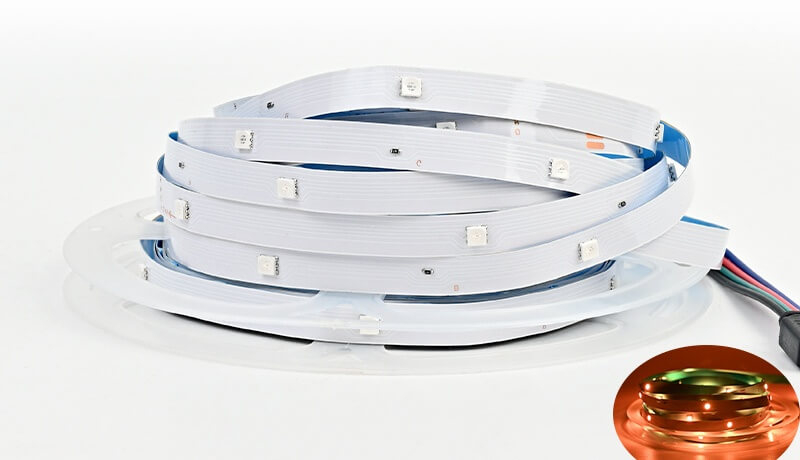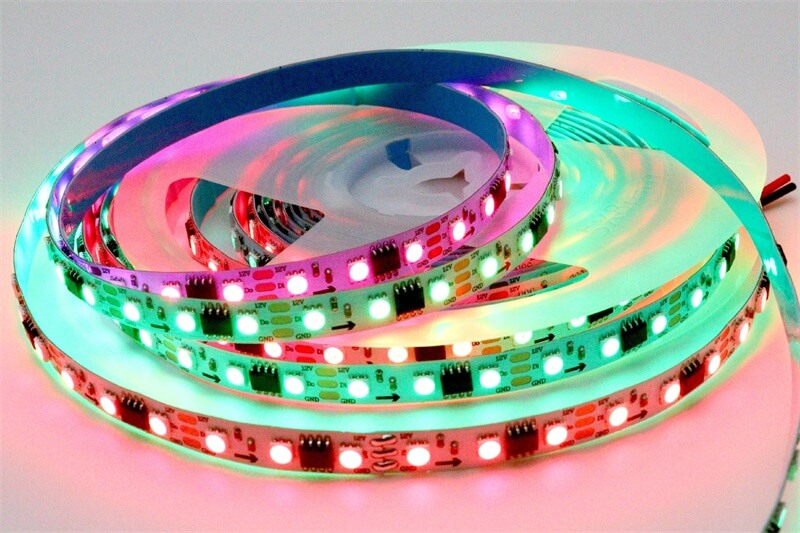High Quality OEM/ODM LED Strip Manufacturer
High Quality OEM/ODM LED Strip Manufacturer
August 28, 2024 211
As lighting technology evolves, LED light strips have become essential in home decor, commercial displays, and architectural lighting. LED light strips can be categorized into regular and programmable types based on their functionality and control methods. This article explores the key differences between programmable and regular LED light strips, focusing on functionality, control methods, application scenarios, and cost-effectiveness.

Regular LED Light Strips
Regular LED light strips typically offer fixed or limited adjustable color and brightness options. They are generally controlled by simple switches, dimmers, or remote controls with limited range. These strips are primarily used for basic lighting or decorative purposes, often providing a single color or limited multi-color options (such as red, green, or blue).
Programmable LED Light Strips
Programmable LED light strips offer advanced features where each LED chip can be individually controlled. This allows users to customize the color, brightness, and dynamic effects through programming or mobile apps. Programmable strips can display complex color gradients, animations, or specific light patterns, and can even sync with music or external sensors. They typically use RGB or RGBW (red, green, blue, white) LED chips, enabling the creation of intricate lighting schemes through controllers or software.

Regular LED Light Strips
Control methods for regular LED light strips are straightforward, usually involving wall switches, remote controls, or basic dimmers. The simplicity of these controls makes installation and use easy but limits flexibility and customization. Users cannot create complex lighting designs based on specific needs.
Programmable LED Light Strips
Programmable LED light strips offer highly flexible control options. Users can operate them via smartphone apps, computer software, voice assistants, or dedicated controllers. These strips often support wireless communication protocols like Wi-Fi, Bluetooth, or Zigbee, allowing real-time adjustments to lighting effects. Additionally, programmable strips can be integrated into smart home systems, enabling automated scene settings such as scheduled on/off, dynamic light changes, or automatic adjustments based on ambient light.
Regular LED Light Strips
Regular LED light strips are ideal for straightforward lighting scenarios, such as background lighting in home decor, under-cabinet task lighting, or simple commercial displays. They are typically used to provide consistent, static lighting, making them suitable for applications that require stable illumination without dynamic changes.
Programmable LED Light Strips
Programmable LED light strips, with their rich functionality and high level of customization, are widely used in scenarios that require complex lighting effects. For example, in home entertainment systems, programmable strips can sync with TVs or audio systems to create an immersive viewing or gaming experience. In commercial displays, these strips can use dynamic effects to capture customer attention and highlight brand identity. Additionally, programmable light strips are also used in architectural facade lighting, stage performances, and holiday decorations, where they can deliver vivid, multi-color displays with strong visual impact.
Regular LED Light Strips
Regular LED light strips are generally less expensive, making them suitable for budget-conscious users with simple lighting needs. Their straightforward functionality results in lower installation and maintenance costs, providing an economical choice for basic lighting applications.
Programmable LED Light Strips
Programmable LED light strips are relatively more expensive, factoring in the initial purchase cost and the configuration of control systems. Additionally, the complexity of installation and programming may require professional assistance, further increasing the overall cost. However, their powerful features and wide range of applications offer higher added value. In settings that require personalized and dynamic lighting solutions, the investment in programmable light strips can yield significant returns.
The differences between programmable and regular LED light strips are significant in terms of functionality, control methods, application scenarios, and cost-effectiveness. Regular LED light strips are suitable for simple, static lighting needs and offer a cost-effective and easy-to-use option. In contrast, programmable LED light strips provide greater flexibility and a broader range of lighting effects, making them ideal for users and environments that demand dynamic, customizable lighting solutions.
When choosing between the two, users should consider their specific lighting requirements, budget, and the intended application to select the most appropriate product type. Whether seeking practicality or creative expression, the market offers a variety of light strip options to meet these needs.
If you need assistance from professionals, feel free to contact us. We are here to provide you with expert help and support for all your needs. Don't hesitate to reach out to our team for personalized assistance and solutions. We look forward to serving you.
Our sales will reply to you within 2 hours.
